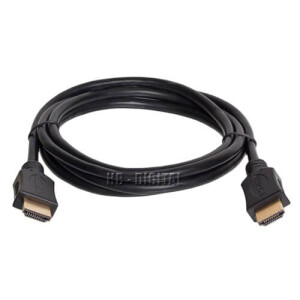Audio & Video Cable
The number of connections even on a household receiver can be shocking, while sound cards, synthesisers, DJ consoles and other music equipment add a dozen more professional connections to the list. Accordingly, each jack requires its own cable.
In this section of our online shop, we have systematised cables and other products for the transmission of different types of signals for you.
So let's start with a small overview of which cables should be used for which signals.
All modern audio and video devices need cables. Every day our customers buy the cables they need for different devices. Customers want to be able to connect one thing to another so that it "works" right away.
For audio transmission
Audio signals come in two varieties: stereo or mono. Special cables called jacks are used for transmission.
Stereo jack sockets have three poles and are designated with the English letters TRS. It stands for Tip, Ring, Sleeve, which means something like "tip", "ring" and "sleeve". Mono jack sockets use the designation TS - without the letter R, which means "without ring". If you look closely, you can see that they do not have a black ring on the sleeve.
There are three main jack diameters: jack 6.35 mm, mini jack 3.5 mm and micro jack 2.5 mm. The largest size is found in professional music equipment, powerful headphones, speakers and microphones. The micro jack is used in portable devices.
If the size of the jack does not fit the socket, an adapter is needed.
For transmitting analogue signals
RCA, or "Cinch", is commonly used to transmit analogue signals. This type of cable connection was invented by the Radio Corporation of America, whose initial letters appear in the connector designation.
RCA plugs have standard colours and simple letter designations for ease of use. It is almost impossible to get lost.
There are a varying number of "tulips" on a cable. One RCA connector is yellow for video or white for mono audio. Two RCA connectors are a special background input for vinyl players. There is usually a separate earth plug on the cable. Three cinch sockets are for the full transmission of audio or video signals. Its colours are yellow, red and white.
For multi-part speaker systems that include rear speakers, subwoofers and surround speakers, six or even eight "tunes" are used.
For FM antennas
Coaxial cables are used to connect FM antennas to televisions, tuners, stereos and monitors. They are available either to plug in or to screw in.
Choosing the type of coaxial cable is easy, as it is usually specified in the product's technical data or operating instructions.
Telephone cable
Telephone cable is a balanced, low-frequency cable used for main and subscriber lines. There are many types of cables with different functional and quality characteristics. Therefore, the type of cable should be selected according to the expected load and operating conditions.
For digital video and multimedia transmission
HDMI - High Definition Multimedia Interface or "High Definition Multimedia Interface" - is used to transmit digital video and multi-channel audio. This makes an HD-quality picture available on the screen.
HDMI replaces RCA, DVI, VGA and other analogue connection standards. It is used in televisions, gaming systems, home theatres, computers and high-resolution monitors. Works with camcorders, smartphones and other mobile devices.
There are three form factors: HDMI Type A, mini-HDMI Type C and micro-HDMI Type D.
For smartphones and technology
A universal USB cable is used to transmit digital information and power devices. The name stands for Universal Serial Bus.
USB connections are divided into different types. There is the standard, type A, for external devices, type B, and for mobile and other portable devices, type C.
For iPhone and Mac
The Apple range of cables is exclusive, and they are genuine.
To charge your Macintosh, you need a Thunderbolt or USB-C cable. They also transfer audio, video and other data over the same connection and can be used with hard drives, monitors and other compatible devices. Thunderbolt replaces Firewire, which was previously present on the Macintosh.
Smartphones on the iPhone now use the Lightning connector, which replaces the 30-pin to USB connector on older models.
When which cables are needed:
- TRS or TS type jacks are required for headphones or microphones
- Analogue video or audio signals require RCA tube jacks
- Digital information is transmitted via an HDMI interface
- USB ports are required to connect or charge computers and peripherals as well as smartphones, tablets and other devices




